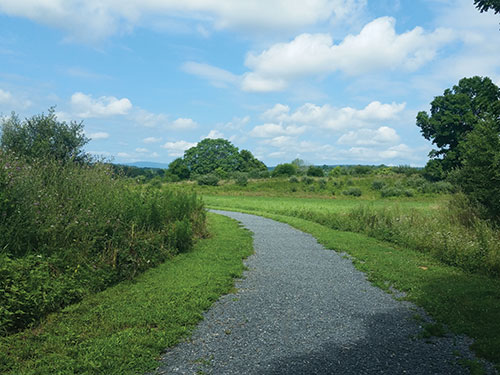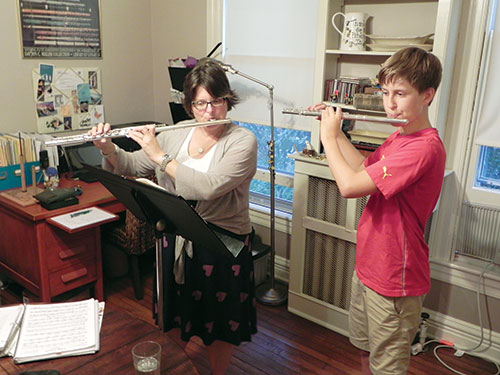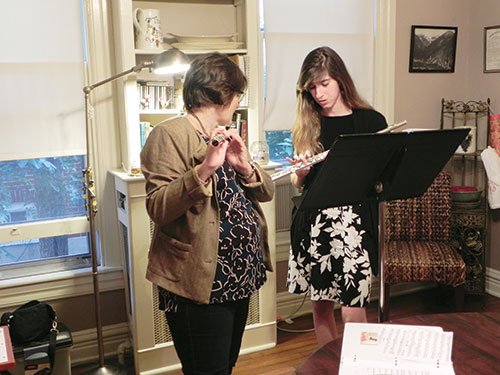When my husband, infant son, and I moved to Winchester, Virginia, I was surprised to learn that, even though Winchester is home to Shenandoah Conservatory, the majority of the local band students do not take private lessons. We moved from Fairfax County, Virginia, a DC Metro area county where nearly every band student takes lessons.
Fairfax County boasts some of the top band programs in the United States. Even families who struggle financially recognize the benefit of lessons and make sacrifices to provide lessons for their children, because that is what is expected in this area. I often joke that when we moved to Fairfax, I announced I was a flute teacher, took one deep breath, and suddenly had 35 students lined up at my door for lessons.
It was quite a culture shock to arrive in Winchester and learn that only a handful of students in the public schools in the area studied privately. While I live in downtown Winchester, a relatively small city, the surrounding counties are still largely agricultural. Those who are not employed in agriculture work factory jobs, within the school system, or at the local hospital. The majority of families here either cannot afford private lessons, or simply do not recognize the value of them.
I was fortunate to have an adjunct position at Shenandoah Conservatory and a bit of freelancing, (as well as my husband’s full-time military band position) to sustain me while I learned, through trial and error, how to establish a vibrant home flute studio in this environment.

Getting Started
Through decades of experience, I have learned that the best recruiting tool for a private flute teacher is to establish and maintain good working relationships with area band directors. My initial step was to contact these directors and offer to teach a free workshop at each school. This helped establish relationships with the directors of the more active programs in the area and provided income, as they often asked me to return for further workshops. Additionally, I was able to provide directors and students with information about my studio.
There were unanticipated benefits to these workshops as well. Teaching fundamentals in a workshop format forced me to streamline my instructions and develop clear wording and examples of what I wanted students to do. Often I was asking these students to play in a way that was different than what they had been taught. For instance, many of the students had been taught to place the flute on the lower lip via the kiss and roll method, which places the flute much too high on the lip for sustained and continued development of a good tone. To convince them that my way worked better, instructions had to be clear enough to ensure the method worked on the first attempt.
Additionally, while I was eventually able to convince some students to take private lessons, there are still many students in our area for whom regular private lessons will never happen. School workshops, group lessons, and even short individual lessons, as the band program can afford them, are the next-best way to get individualized instruction to these students.
What to Charge
The second challenge I had to face was setting an appropriate fee. Lesson rates closer to a major city are usually higher than in a rural setting. I chose not to lower what I charged when we moved to Winchester. If I had stayed in Fairfax, I was due a rate increase, so I felt that maintaining my rate with this move was more than fair. I did notice a few eyeballs widen, and even one jaw drop when I mentioned my fee to local directors and parents. I quickly realized that, excluding full-time faculty at Shenandoah Conservatory, my rate was a good bit higher than the other local teachers were charging.
I did not want to lower my rate. I was a veteran teacher, with experience teaching beginners through university-level students and young professionals, as well as an experienced professional performer. Further, my studio was offering activities beyond traditional lessons, most of which were included in the lesson fee. However, I wanted to find a way to make lessons more financially accessible to students in the area. I added the option of a 45-minute lesson, in addition to 30- and 60-minute sessions. (My students are typically advanced enough to take a full hour, and I prefer this if my schedule allows.) The 45-minute charge is a bit less than the hour rate, and often, if the student is a hard worker, I will stretch those 45 minutes a bit.
I have also had area individuals generously offer, usually anonymously, to help a financially struggling student pay lesson fees. I try to give them updates about the progress of the student they are assisting. I also ask the student beneficiary to write a thank you note, which I deliver. In the case of a known sponsor, the student will thank this individual personally. Once, I even had a student arrive at his sponsor’s place of business and serenade her with flute gratitude. The sponsor was thrilled and went on to help other students as well. I always invite sponsors to attend our spring recital.
In one case, I even agreed to barter for the cost of lessons. I am leery of bartering as I have known colleagues who have felt they received the lesser end of the deal. Agreements should be carefully considered, stated in written format, and signed by all parties. This protects everyone and avoids negative and uncomfortable conversations if one party violates the agreement. My one barter agreement was with a student whose family owned a farm. The student’s grandmother had agreed to pay for a lesson every other week, but I insist students register for 15 weekly lessons for each term (fall and spring). The mother offered to pay me in a farm share for the other half of her daughter’s lesson fees. This student would arrive at every other lesson with a very heavy bag generously loaded with organic, free-range chicken, smoked turkey legs and other meats, as well as a dozen heirloom eggs.
While the student warmed up and perused her sightreading example for the day, I happily stocked my refrigerator and freezer, thinking I could get quite used to being paid in food.

Fundamentals First
Another challenge, convincing students and parents of the value of private lessons, took care of itself as my students began to succeed and soar beyond the expectations of their peers, parents, band directors, and even themselves. This certainly did not happen overnight. My incoming students were nowhere close to the level of my students in Fairfax. I refused to compromise on fundamentals, and it took some time for students and parents to trust me and to believe that these “funny sounds” (harmonic exercises and vibrato work) and scales would eventually help them develop a better tone and technique.
I also insisted that students follow a set curriculum, although with a certain amount of flexibility, depending on the student’s needs, strengths, and goals. My students were not used to spending time on tone development exercises, or even on scales or etudes. I developed “The Daily Flute Workout” (See Flute Talk, April 2013, available at www.flutetalkmagazine.com for a pdf and full details) to encourage them to practice on a regular basis. It is a daily practice guide template that students and I prepare together at each lesson. Most of my students are involved in sports, so calling the practice sheet a workout helps them understand that my expectations for their flute preparation are the same as the those of their swimming coach. I also worked with band directors who were used to assigning certain pieces for solo and ensemble festivals that were just too difficult. I recommended other works that were a better fit for students but still challenged them.

Motivation
Because the schools here are farther apart, the area is more sparsely populated, and the majority of students do not take lessons, students are not as naturally motivated to excel as they often are in a more urban area. Within my studio, I often create challenges to motivate younger students to learn their fundamentals. For instance, to encourage students to learn their scales, I created the “Scary Scales Scaling Bee,” which takes place in October around Halloween. Students come in costume, and I call random scales plucked from slips of paper from a jar, just like calling words in a spelling bee. The winner usually receives a treat purchased from one of the local band’s fall fundraisers. It is stunning how hard students will work for the renowned apple dumplings sold by one of the local band programs.
I have also held an End of Summer Party to motivate students. At the end of one summer, we gathered at the home of a student for a pizza party. Each student brought a favorite pizza topping, and a local pizza restaurant provided the dough rounds to me at cost. Before enjoying the pizza, students had to demonstrate mastery of their summer goals, which were written on a piece of paper on my studio music stand at the beginning of summer for all to see. One student had been having trouble learning her upper register notes. It was great fun for all of the other students to line up and take turns approaching her and pointing at an upper register note in a piece of music. She demonstrated how quickly she could now name and play each note.
I also look to resources outside the studio to inspire my students. In 2011 Larissa West, who had recently earned her master of flute pedagogy degree at Shenandoah Conservatory, founded the Apple Valley Flute Choir. The choir continues under the direction of Carl Bly, a well-known retired Virginia band director. He is assisted by his wife, flutist Randi Bly, who is an experienced performer and teacher. Many of my students participate in this ensemble, which also includes area band directors and adult amateurs. The students gain experience in being the only individual on their part, and they rotate parts for each piece.
Additionally, the flute choir music is quite often in keys students do not regularly see in their school bands. The music is challenging, and Carl is a demanding conductor who knows how to motivate players. With Carl teaching from the front, and Randi and I and other music educators teaching from the side – offering advice in rehearsal on everything from alternate fingerings to when to swab the flute – my students are surrounded by motivation and good role models. Even the adult amateurs set a good example. When a labor and delivery nurse shows up to rehearsal after a grueling hospital shift, still wearing scrubs, flute in hand, prepared and ready to work, this makes an invaluable impression on students about work ethic, commitment, and reliability.
Enrichment
My students usually audition for district band and participate in the solo and ensemble festival, run by area band directors. Once they have taken a few local auditions and are seeing some success with this, I look outside the area. I often have them audition for the Flute Society of Washington’s Mid-Atlantic High School Flute Choir. This is a good first audition experience and culminates with accepted students attending the Mid-Atlantic Convention and playing with the choir. For many of my students, this flute choir or their first All-State Band audition experience is their first exposure to the high level of flute-playing possible by students their age. They often come back from these out-of-area events highly motivated to practice and improve.
I also encourage students to listen, an undervalued activity in our society, even among musicians. I encourage them to take advantage of our close proximity to Shenandoah Conserv-atory, which offers hundreds of performances each year, many of them free or discounted to students. Additionally, I encourage students to listen to good recordings, and to occasionally venture into Washington, D.C. for a concert experience.
Instruments
Another challenge I faced in Winchester was in making a variety of step-up, pre-professional, and professional instruments available to my students. The nearest store with a wide selection is in Washington, DC, and I had difficulty convincing parents that it was worth it to make a trip their for instrument shopping. Most parents will not believe that an instrument upgrade is worth the money and effort until they hear their child play on that instrument. I was fortunate to meet a vendor who was willing to visit my studio once or twice a year.
Buying a flute can be a confusing and scary experience for parents, who may feel they are spending a great deal of money on an object they know little about. I work closely as a liaison between parents, student, and vendor to determine a family’s price range, discuss which flutes might be a good fit for this student and budget, and to arrange a visit (or shipment) during which the student can try the flutes themselves and take a flute or two out on trial. Almost always, when parents hear their child play on an upgraded flute, they are willing to commit to buying the flute. Purchasing using a payment plan option or finding a used flute are good options for families on tight budgets.
I have also encouraged local band directors to purchase better-quality flutes and piccolos for their programs. Often, what seems like a deal can be a frustrating waste of money. This is especially problematic for piccolos. Many times, I have had a student bring in a school piccolo and tell me they have been assigned to play the instrument for an upcoming concert. I commonly hear statements like, “I do not like playing piccolo,” or “I am not good at piccolo.” I respond, “I don’t like playing this piccolo either. And I’m not good on it either. No one could be. It’s a piccolo-shaped object.” Usually, when I inform the band director that I cannot play on the instrument, they realize the need to purchase a higher-quality instrument.
Looking Back
Developing my studio here has been challenging, and there have been some frustrations along the way, but the rewards have been many and greater than I could have imagined. I have developed wonderful friendships and relationships with local families I would have not otherwise met, and I have seen students grow by leaps and bounds. The work ethic in these students is unparalleled. They practice and get the job done without complaint. I could ask for nothing more.

****
The “Aw, Mom” Method
I developed this method because I honestly did not know what else to do. Like the students I currently teach, I grew up in an area where private lessons were not common among the band students. I did not have a private teacher as a beginner. Therefore, when I started teaching, I did not have the slightest idea how to start a new student. It is perhaps unconventional, but I am proud to say that I have never had a student leave their first flute encounter without producing an acceptable tone.
I demonstrate this exercise first, and then repeat with the student following suit. This also works very well in a workshop or sectional.
Have students sit tall in a chair, holding the headjoint only with both hands. Ask them to pout and sigh, much as they would if their mother told them they must clean their room before being allowed to go to the movies with a friend. “Aw, Mom!” Pout and sigh, repeatedly, aiming the air across and down, not up.
Without moving the head, slowly bring the flute into position, continuing to pout and sigh as they do. When I demonstrate this, students are always shocked to discover that I can produce a flute tone with the headjoint a few inches below and forward from my lips. They are further surprised to learn they can easily do this too.
Slowly bring the flute into position below the lips, in the cleft of the chin. The teacher can then make minor adjustments, if any are needed. If the aperture is too big, have students blow through a soda straw to decrease the size of the aperture. If the air stream is misdirected, I hold my hand in front of and below the lip plate, and ask the student to aim at my hand. (I keep hand sanitizer with me when teaching workshops.)
Allowing students to use their own ears to guide the flute into position almost always puts the flute exactly where it needs to be. Additionally, this method puts emphasis on posture, air flow, and listening from the very beginning.






